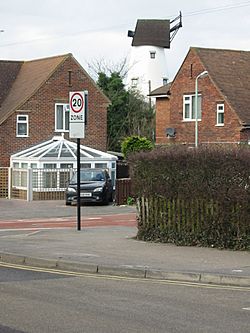St Martin's Mill, Canterbury facts for kids
Quick facts for kids St Martin's Mill, Canterbury |
|
|---|---|
 |
|
| Origin | |
| Mill location | Windmill Close, Canterbury |
| Grid reference | TR 165 578 |
| Coordinates | 51°16′42″N 1°5′48″E / 51.27833°N 1.09667°E |
| Year built | 1817 |
| Information | |
| Purpose | Corn mill |
| Type | Tower mill |
| Storeys | Four storeys |
| No. of sails | Four |
| Type of sails | Patent sails |
| Windshaft | Cast iron |
| Winding | Fantail |
| Fantail blades | Six blades |
| No. of pairs of millstones | Three pairs |
St Martin's Mill is an old windmill in Canterbury, Kent, England. It is a special building, protected because of its history and design. Today, it is no longer a working mill but a house.
Contents
The Story of St Martin's Mill
St Martin's Mill was built a long time ago in 1817. A person named John Adams built it. This windmill was used to grind corn into flour. It worked for many years, helping people get their food.
From Mill to Home
The mill kept working until 1890. After that, it was no longer needed for grinding corn. In 1920, a person called Mr. Couzens changed the mill. He turned it into a house where people could live.
Saving the Mill
In 1958, there was a plan to knock down the old mill. But the government stepped in to save it. They put a special order on the windmill. This order made sure the building would be protected and not destroyed.
The Great Storm
In 1987, a very big storm hit England. It was called the Great Storm of 1987. During this storm, St Martin's Mill lost its large sails. The sails have not been put back on the mill since then.
What St Martin's Mill Looks Like
St Martin's Mill is a type of windmill called a tower mill. It has four floors and is made of brick. The outside of the mill is covered with a smooth layer of cement.
Key Parts of the Mill
- Cap: The top part of the mill was a special "Kentish-style" cap. This cap could turn to face the wind.
- Sails: The mill had four large sails. These were "patent sails," which means they could adjust themselves to catch the wind better.
- Fantail: A small fan on the back of the cap was called a "fantail." It automatically turned the cap and sails into the wind.
- Stage: There was a platform around the mill on the first floor. This was called a "stage." Millers used it to reach the sails.
- Inside the Mill: Inside, the mill had a strong iron rod called a "windshaft." This rod connected the sails to the gears. Some of the original gears, like the "brake wheel" and "wallower," are still there. There was also a system to lift sacks of grain, called a "sack hoist."
- Millstones: The mill used three pairs of large, heavy stones. These "millstones" would grind the corn into flour.

